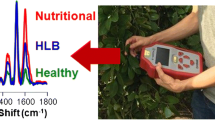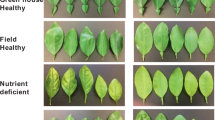Abstract
Main conclusion
Hand-held Raman spectroscopy can be used for confirmatory, non-invasive and non-destructive detection and identification of two haplotypes of Liberibacter disease on tomatoes. Using this spectroscopic approach, structural changes in carotenoids, xylan, cellulose and pectin that are associ-ated with this bacterial disease can be determined.
Abstract
‘Candidatus Liberibacter solanacearum’ (Lso) is a phloem-limited Gram-negative bacterium that infects crops worldwide. In North America, two haplotypes of Lso (LsoA and LsoB) are transmitted by the potato psyllid, Bactericera cockerelli (Sulč), and infect many solanaceous crops such as potato and tomato. Infected plants exhibit chlorosis, severe stunting, leaf cupping, and scorching. Polymerase chain reaction (PCR) and potato tuber frying are commonly used methods for diagnostics of the plant disease caused by Lso. However, they are time-consuming, costly, destructive to the sample, and often not sensitive enough to detect the pathogen in the early infection stage. Raman spectroscopy (RS) is a noninvasive, nondestructive, analytical technique, which probes chemical composition of analyzed samples. In this study, we demonstrate that Lso infection can be diagnosed by non-invasive spectroscopic analysis of tomato leaves three weeks following infection, before the development of aerial symptoms. In combination with chemometric analyses, Raman spectroscopy allows for 80% accurate diagnostics of Liberibacter disease caused by each of the two different haplotypes. This diagnostics approach is portable and sample agnostic, suggesting that it could be utilized for other crops and could be conducted autonomously.


Similar content being viewed by others
References
Adar F (2017) Carotenoids—their resonance Raman spectra and how they can be helpful in characterizing a number of biological systems. Spectroscopy 32(6):12–20
Agarwal UP (2006) Raman imaging to investigate ultrastructure and composition of plant cell walls: distribution of lignin and cellulose in black spruce wood (Picea mariana). Planta 224(5):1141–1153. https://doi.org/10.1007/s00425-006-0295-z
Agarwal UP (2014) 1064 nm FT-Raman spectroscopy for investigations of plant cell walls and other biomass materials. Front Plant Sci 5:1–12
Almeida MR, Alves RS, Nascimbem LB, Stephani R, Poppi RJ, de Oliveira LF (2010) Determination of amylose content in starch using Raman spectroscopy and multivariate calibration analysis. Anal Bioanal Chem 397(7):2693–2701. https://doi.org/10.1007/s00216-010-3566-2
Alvarez AM, Benedict AA, Mizumoto CY, Pollard LW, Civerolo EL (1991) Analysis of Xanthomonas campestris pv citri and X. c. citrumelo with monoclonal-antibodies. Phytopathology 81:857–865
Cao Y, Shen D, Lu Y, Huang J (2006) A Raman-scattering study on the net orientation of biomacromolecules in the outer epidermal walls of mature wheat stems (Triticum aestivum). Ann Bot 97:1091–1094
Civerolo EL, Fan F (1982) Xanthomonas campestris pv citri detection and identification by enzyme-linked immunosorbent-assay. Plant Dis 66:231–236
Cubero J, Graham JH (2002) Genetic relationship among worldwide strains of Xanthomonas causing canker in citrus species and de-sign of new primers for their identification by PCR. Appl Environ Microbiol 68:1257–1264
Devitt G, Howard K, Mudher A, Mahajan S (2018) Raman spectroscopy: an emerging tool in neurodegenerative disease research and diagnosis. ACS Chem Neurosci 9:404–420. https://doi.org/10.1021/acschemneuro.7b00413
Edwards HGM, Farwell DW, Webster D (1997a) FT Raman microscopy of untreated natural plant fibres. Spectrochim Acta A 53A(13):2383–2392
Edwards HGM, Farwell DW, Webster D (1997b) FT Raman microscopy of untreated natural plant fibres. Spectrochim Acta A 53(13):2383–2392. https://doi.org/10.1016/S1386-1425(97)00178-9
Egging V, Nguyen J, Kurouski D (2018) Detection and identification of fungal infections in intact wheat and sorghum grain using a hand-held Raman spectrometer. Anal Chem 90(14):8616–8621. https://doi.org/10.1021/acs.analchem.8b01863
Farber C, Kurouski D (2018) Detection and identification of plant pathogens on maize kernels with a hand-held Raman spectrometer. Anal Chem 90(5):3009–3012. https://doi.org/10.1021/acs.analchem.8b00222
Glynn J, Islam M, Bai Y, Lan S, Wen A, Gudmestad N, Civerolo E, Lin H (2012) Multilocus sequence typing of ‘Candidatus Liberibacter solanacearum’ isolates from North America and New Zealand. Plant Pathol J 94(1):223–228
Golmohammadi M, Cubero J, Penalver J, Quesada JM, Lopez MM, Llop P (2007) Diagnosis of Xanthomonas axonopodis pv. citri, causal agent of citrus canker, in commercial fruits by isolation and PCR-based methods. J Appl Microbiol 103(6):2309–2315. https://doi.org/10.1111/j.1365-2672.2007.03484.x
Haapalainen ML, Wang J, Latvala S, Lehtonen MT, Pirhonen M, Nissinen AI (2018) Genetic variation of ‘Candidatus Liberibacter solanacearum’ haplotype C and identification of a novel haplotype from Trioza urticae and stinging nettle. Phytopathology 108:925–934
Harrison K, Tamborindeguy C, Scheuring DC, Herrera AM, Silva A, Badillo-Vargas IE, Miller JC, Levy JG (2019) Differences in zebra chip severity between ‘Candidatus Liberibacter solanacearum’ haplotypes in Texas. Am J Potato Res 96(1):86–93
Kang L, Wang K, Li X, Zou B (2016) High pressure structural investigation of benzoic acid: Raman spectroscopy and x-ray diffraction. J Phys Chem C 120(27):14758–14766. https://doi.org/10.1021/acs.jpcc.6b05001
Kurouski D, Van Duyne RP, Lednev IK (2015) Exploring the structure and formation mechanism of amyloid fibrils by Raman spectroscopy: a review. Analyst 140(15):4967–4980. https://doi.org/10.1039/c5an00342c
Levy J, Ravindran A, Gross D, Tamborindeguy C, Pierson E (2011) Translocation of ‘Candidatus Liberibacter solanacearum’, the zebra chip pathogen, in potato and tomato. Phytopathology 101(11):1285–1291
Li W, Abad JA, French-Monar RD, Rascoe J, Wen A, Gudmestad NC, Secor GA, Lee M, Duan Y, Levy L (2009) Multiplex real-time PCR for detection, identification and quantification of ‘Candidatus Liberibacter solanacearum’ in potato plants with zebra chip. J Microbiol Methods 78(1):59–65
Liefting LW, Sutherland PW, Ward LI, Paice KL, Weir BS, Clover GR (2009a) A new ‘Candidatus Liberibacter’ species associated with diseases of solanaceous crops. Plant Dis 93(3):208–214
Liefting LW, Weir BS, Pennycook SR, Clover GR (2009b) ‘Candidatus Liberibacter solanacearum’, associated with plants in the family Solanaceae. Int J Syst Evol Microbiol 59(9):2274–2276
Lin H, Islam MS, Bai Y, Wen A, Lan S, Gudmestad NC, Civerolo EL (2012) Genetic diversity of ‘Cadidatus Liberibacter solanacearum’ strains in the United States and Mexico revealed by simple sequence repeat markers. Eur J Plant Pathol 132(2):297–308
Liu D, Trumble JT (2004) Tomato psyllid behavioral responses to tomato plant lines and interactions of plant lines with insecticides. J Econ Entomol 97(3):1078–1085
Mahnke M, Farber C, Sanchez L, Kurouski D (2019a) Advanced spectroscopic techniques for plant disease diagnostics: a review. Trends Analyt Chem 118:43–49
Mahnke M, Farber C, Sanchez L, Kurouski D (2019b) Advanced spectroscopic techniques for plant disease diagnostics: a review. Trends Anal Chem 118:43–49
Mary YS, Panicker CY, Varghese HT (2012) Vibrational Spectroscopic Investigations of 4-nitropyrocatechol. Orient J Chem 28(2):937–941
Nachappa P, Levy J, Pierson E, Tamborindeguy C (2014) Correlation between “Candidatus Liberibacter solanacearum” infection levels and fecundity in its psyllid vector. J Invertebr Pathol 115:55–61
Nelson WR, Sengoda VG, Alfaro-Fernandez AO, Font MI, Crosslin JM, Munyaneza JE (2013) A new haplotype of “Candidatus Liberibacter solanacearum” identified in the Mediterranean region. Eur J Plant Pathol 135(4):633–639
Ravindran A, Levy J, Pierson E, Gross DC (2012) Development of a loop-mediated isothermal amplification procedure as a sensitive and rapid method for detection of 'candidatus Liberibacter solanacearum' in potatoes and Psyllids. Phytopathology 102(9):899–907. https://doi.org/10.1094/phyto-03-12-0055-r
Sanchez L, Farber C, Lei J, Zhu-Salzman K, Kurouski D (2019a) Noninvasive and nondestructive detection of cowpea bruchid within cowpea seeds with a hand-held Raman spectrometer. Anal Chem 91(3):1733–1737. https://doi.org/10.1021/acs.analchem.8b05555
Sanchez L, Pant S, Xing Z, Mandadi K, Kurouski D (2019b) Rapid and noninvasive diagnostics of Huanglongbing and nutrient deficits on citrus trees with a handheld Raman spectrometer. Anal Bioanal Chem 411:3125–3133
Swisher Grimm K, Garczynski S (2019) Identification of a New Haplotype of ‘Candidatus Liberibacter solanacearum’ in Solanum tuberosum. Plant Dis 103(3):468–474
Synytsya A, Čopíková J, Matějka P, Machovič V (2003) Fourier transform Raman and infrared spectroscopy of pectins. Carbohydr Polym 54:97–106
Tamborindeguy C, Huot OB, Ibanez F, Levy J (2017) The influence of bacteria on multi-trophic interactions among plants, psyllids, and pathogen. Insect Sci 24:961–974
Trumble J (2009) Potato psyllid. Center for Invasive Species Research, University of California Riverside, California
Tschirner N, Brose K, Schenderlein M, Zouni A, Schlodder E, Mroginski MA, Hildebrandt P, Thomsen C (2009) The anomaly of the ν1-resonance Raman band of bβ-carotene in solution and in photosystem I and II. Phys Status Solidi (b) 246(11–12):2790–2793. https://doi.org/10.1002/pssb.200982299
Yao J, Saenkham P, Levy J, Ibanez F, Noroy C, Mendoza A, Huot O, Meyer DF, Tamborindeguy C (2016) Interactions ‘Candidatus Liberibacter solanacearum’—Bactericera cockerelli: haplotype effect on vector fitness and gene expression analyses. Front Cell Infect Microbiol 6:62
Yu MM, Schulze HG, Jetter R, Blades MW, Turner RF (2007) Raman microspectroscopic analysis of triterpenoids found in plant cuticles. Appl Spectrosc 61(1):32–37. https://doi.org/10.1366/000370207779701352
Acknowledgements
This study was supported by funds from Texas A&M AgriLife Research, Texas A&M University Governor’s University Research Initiative (GURI) grant program of (12-2016/M1700437) (DK) and T3 grant from Texas A&M University (DK and CT), Texas A&M AgriLife Research (Controlling Exotic and Invasive Insect-Transmitted Pathogens) (CT) and Hatch project TEX0-1-9381 Accession Number 1015773. Xiaotian Tang received the Herb Dean’40 Endowed Scholarship from the Department of Entomology at Texas A&M University.
Author information
Authors and Affiliations
Corresponding author
Additional information
Communicated by Anastasios Melis.
Publisher's Note
Springer Nature remains neutral with regard to jurisdictional claims in published maps and institutional affiliations.
Electronic supplementary material
Below is the link to the electronic supplementary material.
Rights and permissions
About this article
Cite this article
Sanchez, L., Ermolenkov, A., Tang, XT. et al. Non-invasive diagnostics of Liberibacter disease on tomatoes using a hand-held Raman spectrometer. Planta 251, 64 (2020). https://doi.org/10.1007/s00425-020-03359-5
Received:
Accepted:
Published:
DOI: https://doi.org/10.1007/s00425-020-03359-5




